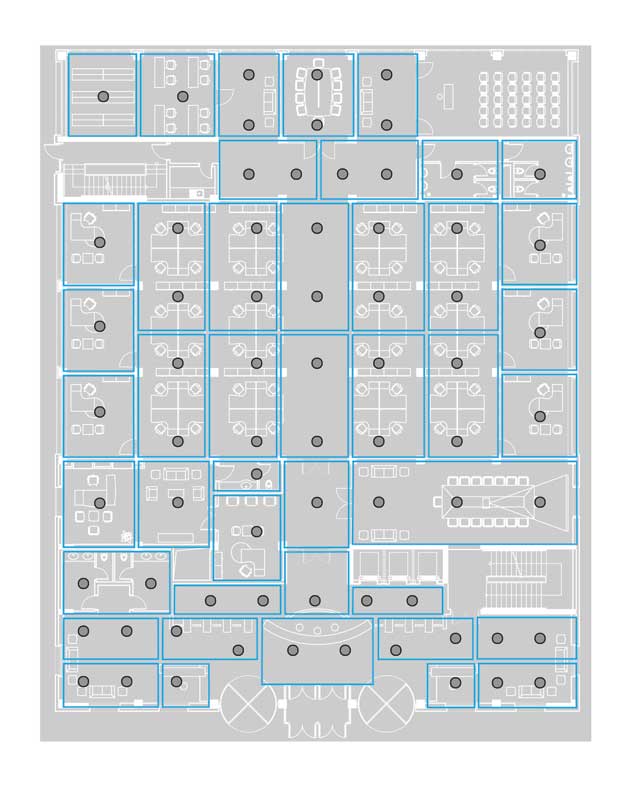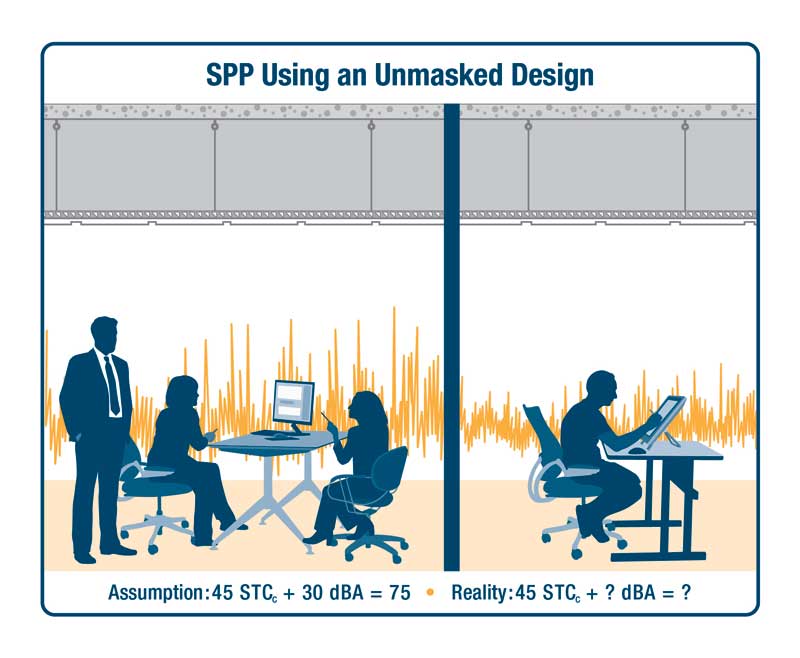A new approach to acoustics

Image courtesy K.R. Moeller Associates Ltd.
Sound masking
A sound masking system uses a series of electronic components and loudspeakers to distribute a sound most people compare to softly blowing air. However, unlike HVAC, the sound is not only continuous, but also precisely controllable.
Though this technology is often referred by the term ‘white noise,’ modern systems do not utilize a particular color of sound. (Most people are not thinking of the technical implications when they say ‘white noise.’ However, this particular spectrum of sound has not been used by masking systems since the 1970s. White noise is a random ‘broadband’ sound—meaning it includes a wide range of frequencies—typically spanning the audible range of 20 to 20,000 hertz [Hz]. While it is an effective masker, it is also irritating. Most people describe it as ‘static’ due to its uncomfortable, hissing quality.) Rather, they are engineered so their output can be tuned post-occupancy in order to provide a spectrum or ‘curve’ specifically designed to balance acoustic control and comfort.
The advent of localized computer tuning—whereby software adjusts the system’s output in order to meet the masking curve throughout all treated areas—means a minimum background sound level is now a readily deliverable component of architectural acoustic design. Building professionals can use this predictable, controlled level as the foundation for the remainder of their acoustical plan.
Formula for success
When preparing “Sound & Vibration 2.0: Design Guidelines for Health Care Facilities”—the companion document to the Facility Guidelines Institute’s (FGI’s) 2014 Guidelines for Design and Construction of Hospitals and Outpatient Facilities—acousticians developed a formula providing a predictive model for this approach. Basically, to “achieve confidential speech privacy the sum of the composite STC and the A-weighted background noise level shall be at least 75,” or STCc + dBA ≥ 75. Some refer to this formula as speech privacy potential (SPP). (It is important to note this formula is based on the composite STC [STCc] of the partition assembly rather than the wall rating alone—a distinction often lost on those untrained in acoustic design. STCc includes the negative impact on acoustic performance when elements such as doors and windows are added to the partition. For example, an STC-50 partition can degrade by as much as 23 points when un-gasketed door covering 20 percent of the wall is installed.)
As dBA is assumed to be 30, STCc must be at least 45 to achieve the combined total of 75. Using masking to apply a continuous level of 30 dBA eliminates the variability of the source, and speech privacy is more reliably achieved with the stated STCc. The curve generated by a professionally tuned masking system is also precise. Therefore, the speech privacy it provides is greater than the typically erratic spectrum produced by HVAC, even at the same volume.
While the need for speech privacy is obvious to organizations consistently dealing with sensitive information—such as hospitals and law offices—most people expect conversations occurring within closed rooms to remain private, making SPP broadly applicable. Even if an organization decides it is more motivated by the need for a high-performance workplace than speech privacy, taking the steps required to lower speech intelligibility allows them to reap both rewards. (For the same reasons, masking should also be applied within the open plan, where it is typically set to 46 to 48 dBA.)

Images courtesy K.R. Moeller Associates Ltd. and Screen Solutions UK
Cost savings
In the above scenario, the masking sound is set to a level far below the one used in traditional applications. Despite being barely audible, it still provides the minimum necessary to accurately plan the remaining design elements. However, there are significant opportunities for further value engineering because the predictable overall volume and spectrum allows one to reduce the specifications for the room’s physical shell.
If speech privacy equals STCc + 30 dBA ≥ 75, then, for every 1-dBA increase in the background sound level, it is possible to reduce STCc by one point and achieve the equivalent level of speech privacy. Were the background sound to be increased from 30 dBA to 35 dBA, for instance, construction costs for partition types would start to drop significantly because the STCc could be reduced by five points.
Again, 30 dBA—and, indeed, even 35 dBA—is well below typical masking levels in closed rooms. Usually, they are set between 40 and 43 dBA in such spaces. Depending on various factors, including occupant comfort, they may be set higher. Therefore, although 30 dBA can be used as a design benchmark, the lowest STCc rating possible to achieve an SPP of 75 is actually determined by the highest comfortable level of continuous minimum background sound. (The recommended maximum masking levels are still so low as to not to affect face-to-face communication or hearing. Since the decibel scale is logarithmic, the difference between 48 dBA [the typical maximum for open plan] and 80 dBA [the point at which hearing concerns begin, with prolonged exposure] is dramatic. Expressed in terms of distance, if 80 dBA is equivalent to 1.6 km [1 mi], 48 dBA is only 1 m [39 in.]. Also, conversation generally falls into the range of 50 to 60 dBA. In other words, sound masking is also set to a far lower level than a lot of sounds one regularly encounters in everyday life.)
With a suitable design of sound masking, walls, and ceilings, it is also possible to achieve privacy with walls built to the suspended ceiling rather than to the structure. In one example, a major U.S. healthcare provider changed its construction standards for medical office buildings away from deck-to-deck construction. After significant testing of mockup facilities, the company determined they achieved as good or better speech privacy with ceiling-height walls and sound masking. They reported cost savings of hundreds of thousands of dollars for a project of just over 2787 m2 (30,000 sf).








